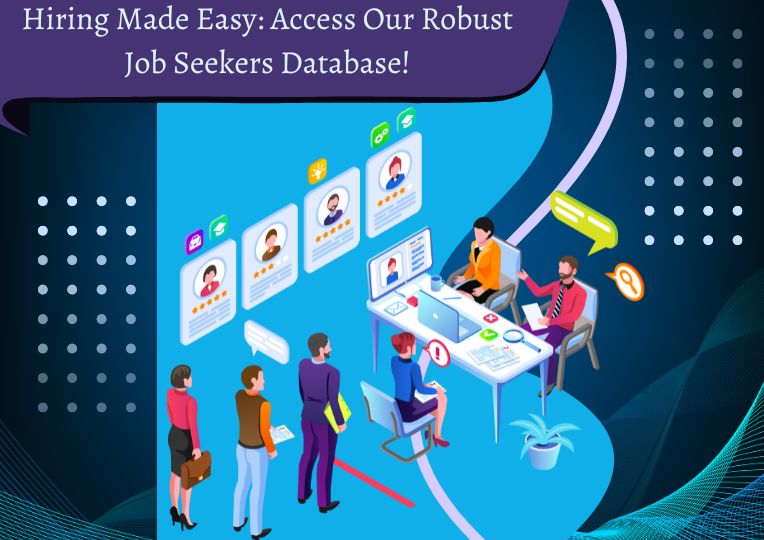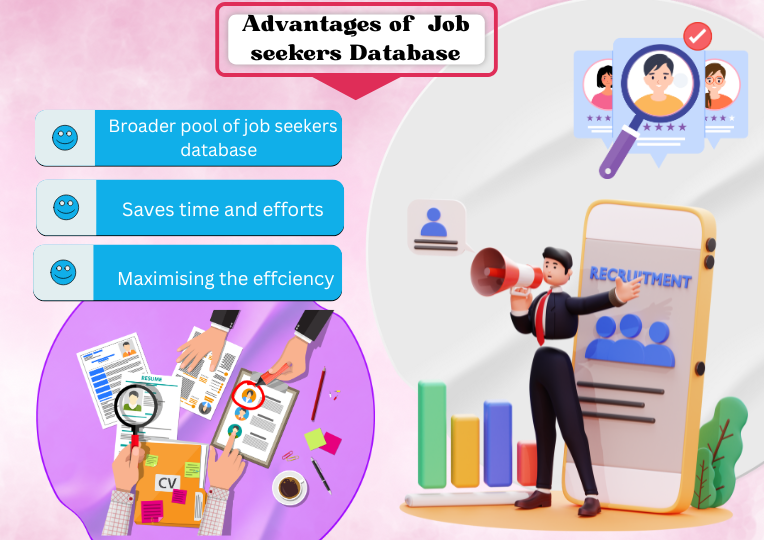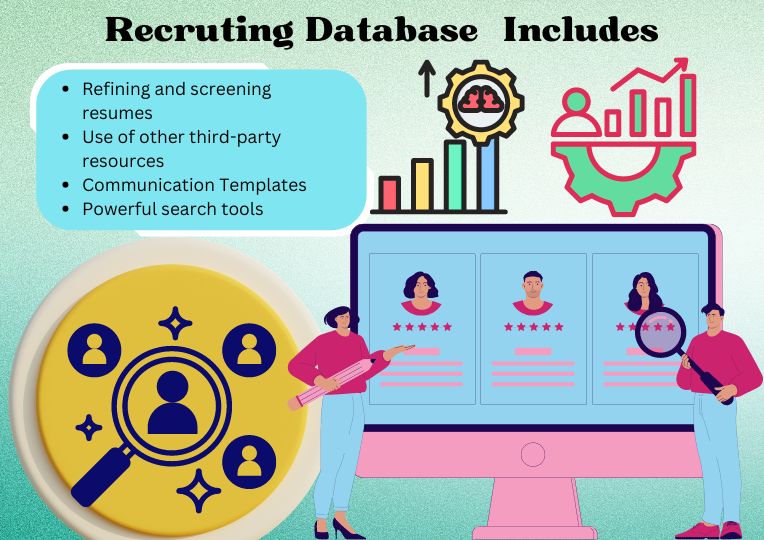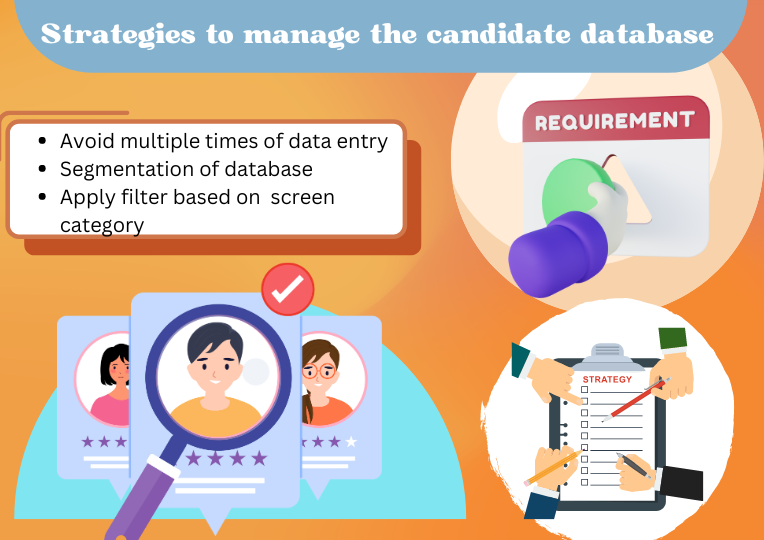Blogs
How to Utilize a Job Seekers Database for Recruitment?
Establishing a solid basis for your recruiting business’s success begins with a Job Seekers Database. Think about how much easier it would be if you could identify the ideal applicant faster than your competition. The power of an excellent recruitment database is like magic!
Investing in a reliable recruiting database is crucial for recruiters who want to keep up with the changing demands of their customers and applicants. Keep reading to know more about the Job Seekers Database for Recruitment.

What is a Recruitment Database?
When a new position opens up, you may find qualified applicants by searching a Job Seekers Database. Assume for a moment that you need a software engineer fluent in C# and Dotnet. Finding resumes from various sources and saving them in spreadsheets or emails would be tedious and time-consuming.
Searching for individuals with certain talents becomes much easier when you use a recruiting database to organize resumes according to pertinent keywords, experience, and credentials.
A Recruiting Database’s Advantages
Using a Job Seekers Database is one way to make the hiring process more efficient and productive. All the techniques to maximize its utilization are as follows:
The huge passive candidate pool
A Job Seekers Database gives you access to a broader pool of applicants, including individuals who aren’t actively looking for work but have the expertise and talents your business is looking for rather than the narrow pool of people drawn to traditional job ads. To better fulfil your future personnel needs and have access to a bigger talent pool, it is advisable to identify and engage with these prospects.
Cut down on filling time
Using a Job Seekers Database, you may save time and effort while searching for candidates. Not going through the whole hiring process to fill a new position reduces the need to use job boards. You may save time and effort by searching your applicant database for the ideal fit for open positions rather than advertising the position and then waiting for applications.
Cut down on administrative time by hours
Thanks to the recruiting database, there will be much less of a need to spend time on administrative duties. It eliminates the need for bulky storage solutions like email, hard discs, and spreadsheets. It compiles all candidate data into one easily searchable repository to save your time and effort.
Maximise efficiency in teamwork
With the help of a recruiting database, the hiring process becomes much more streamlined. No more tedious back-and-forth emails or spreadsheet updates—all team members can see and edit candidate details in real time.

What Exactly Does a Recruiting Database Consist Of?
A recruiting database consists of the following information:
Refining and Screening Resumes:
Automating repetitive processes, such as reformatting resumes, frees up human resources to focus on improving the recruiting process and making better hires. Invest in a database programme for recruiting with an integrated resume reformatting tool so you can quickly reformat many resumes!
Use of Other Third-Party Resources:
Application tracking systems, job boards, and automation tools are all examples of external or third-party resources that your ideal Job Seekers Database software should interact with simply. This will allow you to expand more efficiently.
Recruitment Databases Need Communication Templates:
You don’t have to do everything by hand when sending out recurring communications like application emails, interview communications, or offer letters. The ideal programme for the recruiter would offer basic-level templates and help you save time.
Powerful Search Tools:
Job Seekers Database software requires more than just a type-and-enter search tool. You want software capable of doing sophisticated boolean searches to get even the most complex facts from your database. In addition, the ability to identify and filter data is usually helpful.
Safeguarding and Adherence:
To keep your agency’s good name and attract top talent, you must use fair recruiting techniques and safeguard your prospects’ personal information. To be compliant, you need software that does it for you. Anonymize sensitive information from candidates’ resumes and eradicate prejudice from your recruiting process with our resume reformatting tool.

How Can You Determine Which Recruiting Database Is Most Suited To Your Company?
When deciding on a Job Seekers Database for your company, keep the following in mind:
All of your needs are met at one convenient location
There has to be a central location for all job postings, candidate searches, and the selection/rejection processes. The procedure should be smooth and uncomplicated, eliminating the need for numerous platforms to meet diverse objectives.
Simple organization through tagging
Admins can more easily access particular candidate data via tagging. Also, the process of vetting potential employees should be easy and uncomplicated.
Assignment of tasks
Even though this wasn’t an option in earlier recruitment databases, it’s a plus today. Posting job vacancies on various portals, social media platforms, and job boards is a capability of a contemporary applicant database.
Determine where your applications are coming from
If you want to know where to find qualified candidates, a solid Job Seekers Database will tell you. You will discover the most significant source for your prospects, whether from a social networking platform, a job portal, or some other location.
In What Ways Is A Recruiting Database Managed?
If you want your recruiting database to be accurate, relevant, and valuable, keep it current. Here’s a recommended approach:
- To make searching easier, apply candidate segmentation. One way to categorize them is as:
- Potential employees who respond to your job postings
- Prospects whose profiles you import into your applicant tracking system (ATS) from external sources
- Postings for candidates with relevant expertise and relevant work history
- Integrate a data-extracting parsing engine into your applicant tracking system to automate data input. It should be capable of automatically filling out fields in job, contact, and applicant records.
- Screen new database entries regularly. However, keep in mind that quality applicants are more critical than quantity.
- Before entering candidate data into the database, ensure it passes a quality control test.
- Occasionally, archive candidates who have not taken any action.
Expert Strategies for Managing Your Candidate Database
Job Seekers Database management is difficult. Good management will help the hiring process. Manage the application database for efficient data reversal and searching. This post should help you organise your application database. Let’s begin.
Organizing Ahead Of Time
The Job Seekers Database should be ready before the employment process begins to avoid data pileup and manual maintenance headaches. This will allow for immediate data entry. So, to make the candidate database more manageable, create a strategy. It is possible to add or change database categories later as needed.
Make use of an application tracking system (ATS)
An application tracking system (ATS) is the easiest and most effective way to manage candidates. A data-centric strategy and multi-platform job advertising make discovering quality applicants simpler. Application tracking systems are the latest AI-automated recruiting tech. ATS can determine the best resume for the job by assessing candidates’ skills, qualifications, experience, and keywords.
Apply a filter based on the screen category
The best way for recruiters to preserve resumes for future use is to develop a system to import and process them. All candidates, including those you bring into your application tracking system (ATS) through third-party tools like aggregators and boards, are subject to this policy. When searching for qualified applicants in the future, use your filtered list as a conduit.
Prioritise abilities above keywords
You and your team will find these applicants more easily using keywords. By following these steps, you may avoid applicants who try to trick you by artificially inflating their resume rankings with keywords and reduce your dependency on sophisticated or boolean searches. One way to swiftly find suitable people is to enter their abilities in the applicant database. This will help you filter out the proper profile.
Stay away from repeated entries
Duplicate entries shouldn’t be a problem with your applicant tracking system. The candidate database becomes clustered and bulky as a result of data duplication. This can be the result of seeking out applicants from various locations. Thus, your recruiting software should notify you of new candidates when you add them to your database by comparing their data with current workers, including email addresses, first and last names, phone numbers, etc. These will make administering the database easier, save time, and help you organize your data.
Segmenting databases
Make sure to divide your applicant database into several sections according to factors such as region, language, experience, talents, etc. This maintains the Job Seekers Database in an organized state and makes it easier to locate candidate data. Adding tags based on qualifications might further simplify the sourcing process. As a rule, talents are a reasonable tag to utilize. A well-managed applicant database aims to swiftly and easily locate qualified individuals who are a good fit for the open positions within an organization.
Instructions for entering data
The recruiters will need to establish standards for data entry and new records to filter candidates. The well-organized and tagged candidate data should also serve as a model for the recruiters to follow throughout and after the hiring process. This maintains order in the database and ensures consistency.

Conclusion
Whether automating routine recruiting operations or sourcing and maintaining candidate data, the All India Database can help agencies streamline their recruitment. Although it lacks built-in database capabilities, it allows for integrating databases, providing comprehensive applicant-tracking capabilities. If you are curious about the Job Seekers Database and want assistance, contact us for further support.